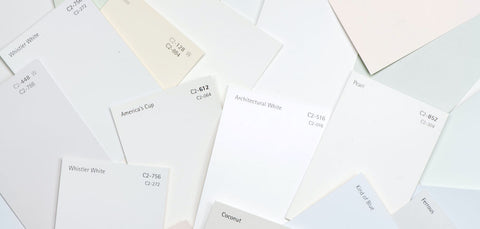Getting it White: Tips for Choosing the Perfect Shade
by Philippa Radon
Many of us hold a connection to the potent silence of white...a blank page, a clean canvas, an empty plate or vacant space, beckoning for the arrival of inspiration and creativity. Though white might seem like an easy choice, picking the right one seems to challenge even the savviest color lovers.
White’s infinite range and numerous undertones confirm the complexities of working with this shade, reminding us of the mysteries it possesses. At the same time, white reconfirms one of the most basic (and important) design elements: light.
The best starting point is to determine a few key facts.
1. Consider the Tone
There are two base tones to white: warm or cool. Warm whites offer a more yellow, soothing undertone, have a softer appearance and can be cozy and welcoming, especially in large open spaces. However, when choosing a warm white make sure that they don't come off as being "too yellow".

Cool whites feel crisper and cleaner, have a bluer, more energizing undertone, and pair best with the blues, greens and the cooler grey colour range.

2. Determine the Natural Light
Gauge what the overall "temperature" of the space is: does it look and feel warm or cool?
-
How much natural sunlight does the room receive?
-
Do you feel bathed in natural light most of the day, or certain times of the day?
-
Do you use artificial light in the daytime?
-
Are certain pockets of the room in shadow?
If still unsure, use an oversized paint chip like a C2 UPC (Ultimate Paint Chip) in a few different shades to see which one looks best, day and night.
3. Note Which Direction the Room Faces
- North facing rooms tend to offer good natural, indirect light - which is cooler
-
South-facing rooms will get the most sun during the day - and feel brightest
-
East-facing, will receive morning light and are lonely with accent warmer colours
-
West-facing rooms benefit evening light best - during the day they tend to be greyer and in shadow
4. Pay Attention to your Artificial Lighting Choices

If you take the time to select the perfect white with the right undertone, make sure your selected lighting accentuates the design.
I like using carefully curated bulbs and fixtures to create an inviting atmosphere and building layers of light that blend well together.
Whether you are looking for low-lit ambiance or to brighten an entire space, there is a bulb for that. Most stores will offer advice on which type of bulb will best serve your space, but in the meantime, here is a guide to choosing the right bulb from HGTV.
5. Use a High-Quality Paint
Especially when it comes to white, it's imperative to use a product with premium ingredients. C2's finely ground artist-grade pigments to create paint with exceptional vibrancy and unsurpassed application. The "full-spectrum" approach includes multiple colorants and NO BLACK (which can often dull the color) so the result is luminous and reflective.

C2 is known for its strong selection of whites, which helps take the headache out of trying to decide between these often indistinguishable hues.
_________________________________________
Some of My Favourite Whites:
- Sheer (C2-804) - a warm, soft white (my #1 go-to)
- Architectural White (C2-501) - a good neutral white that's perfect for accenting clean lines and architectural detail
- Lumen (C2-948) - this warm white flickers like the soft glow of a candle, and is perfect for rooms with lots of natural light.
- Whistler White (C2-756) - a perfect backdrop for artwork
- Milk Moustache (C2-692) - a softer neutral white with more undertones (which makes it more versatile)
Designer Tip: Adding tactile, textural elements like natural wood, fur or coarser weave fabrics into a white space, and lots of oversized foliage creates a sense of harmony.












